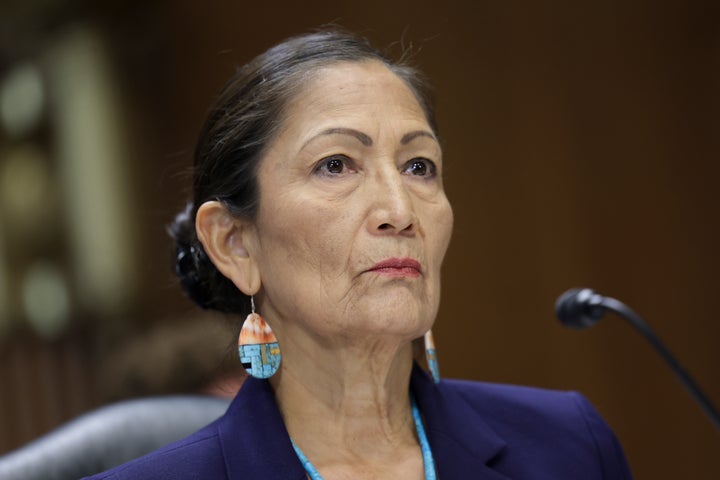Interior Secretary Deb Haaland delivered devastating testimony Wednesday about the U.S. government’s decades-long policy of forcibly removing Native American children from their families and putting them into violent, far-away boarding schools intended to assimilate them into white culture.
“The consequences of federal Indian boarding school policies — including the intergenerational trauma caused by forced family separation and cultural eradication—were inflicted on generations of children as young as 4 years old and are heartbreaking,” Haaland told the Senate Committee on Indian Affairs, which held a hearing to review a first-of-its-kind investigative report from the Interior Department that examines how, exactly, the government set up its policy for rounding up Indigenous children for all those years.
The report marks the first time in more than 200 years that the U.S. has formally reviewed or even acknowledged the scope and breadth of its former policies aimed at erasing Native American culture, language and people.
The Interior Department ran hundreds of these boarding schools from 1819 to 1969 all over the country. Tens of thousands of children endured extensive psychological, physical and sexual abuse. Some died. Others simply disappeared. The goal of these schools, as the founder of one of the flagship boarding schools, Lt. Col. Richard Henry Pratt, put it in 1879, was to “Kill the Indian, save the man.”
Haaland, the nation’s first Native American Cabinet secretary, shared some of the report’s key findings with the committee. The report is part of a broader effort at the Interior Department, along with a legislative effort in Congress, to help bring overdue reconciliation and healing to Indigenous people.
The department’s review of federal records found that the government targeted the removal of Indigenous children as part of a broader effort to take land away from tribes. The report also found that the federal Indian boarding school system consisted of 408 schools across 37 states or then-territories, including 21 in Alaska and seven in Hawaii.
In addition, the report found that roughly 50% of federal Indian boarding schools may have received money or personnel from a religious institution or organization. At times the federal government paid religious groups for Native children to enter federal Indian boarding schools that these institutions and organizations operated.
“Like all Native people, I am a product of these horrific assimilation-era policies,” Haaland said, choking up. “My grandparents were removed from their families to federal Indian boarding schools when they were only 8 years old and forced to live away from their parents … until they were 13 years old.”

The interior secretary said investigators have identified at least 53 schools with marked or unmarked burial sites where Native American children’s bodies were put when they died at school. The report shared in Wednesday’s hearing is Volume 1; the next volume is expected to identify more burial sites and potentially more details about Indian boarding school sites, the children who were there and the operating dates of facilities.
Interior Department officials also plan to start going into tribal communities and hearing from survivors of former Indian boarding schools and descendants of students. The first listening session will take place in Oklahoma, and the department is working with the Department of Health and Human Services to have medical providers on site to help people work through the trauma they may feel in retelling what they or their families have been through.
“We’re working with tribes to make sure we are reaching out, so they are helping us design where to have sessions,” Haaland told the committee. “We want to make sure we are documenting this. If folks want to share publicly, they can. We will close this off to the public so if people don’t want to share with the public, they can.”
The interior secretary noted that it wasn’t lost on her that she is now leading the department that once tried to wipe out Native American people, including her.
“I am in a unique position to address the lasting impacts of these policies,” said Haaland. “I now have direct oversight over the very department that operated and oversaw the implementation of the federal Indian boarding school system.”

